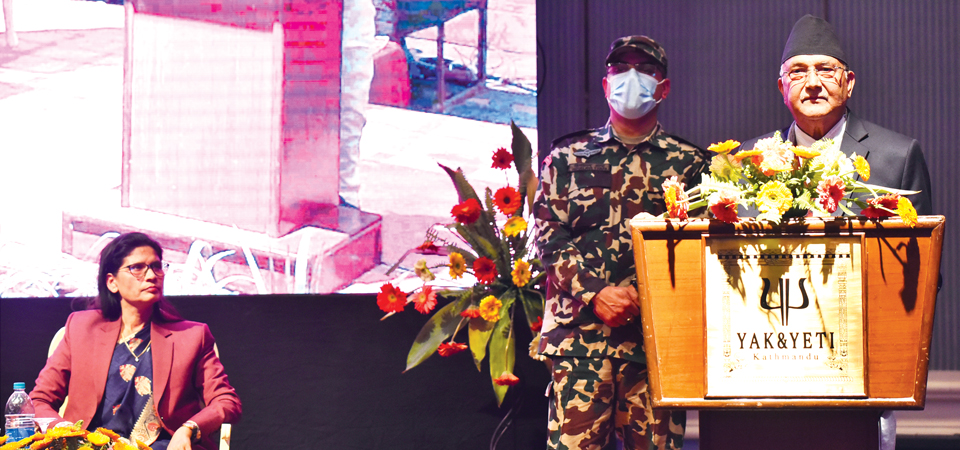Govt launches Digital Soil Map

By A Staff Reporter
Kathmandu, Feb. 25: The government has launched the Digital Soil Map (DSM) – a digital platform designed to give information on soil properties of Nepal on Wednesday.
Prime Minister KP Sharma Oli officially launched the platform developed by the Nepal Agricultural Research Council (NARC)’s National Soil Science Research Centre in collaboration with USAID’s Nepal Seed and Fertiliser Project.
The DSM provides access to location-specific information on soil properties, including soil texture, soil pH, organic matter, nitrogen, available phosphorus and potassium, and micronutrients zinc and boron across Nepal’s arable land.
The web portal of the soil map allows the users, including farmers themselves, to identify a domain with similar soil properties and look at their soil fertility status, said Deepak Bhandari, Executive Director of NARC. “It is a milestone which is a combination of the latest research information and digital technology,” he said.
With a single click, the web portal of the map will allow the users to get information on soil for any province, district, municipality or a particular area of interest and download the results in a map or tabular format, said NARC in its statement.
The DSM will also be useful to make new crop and site specific fertiliser recommendations for the country. Using these recommendations, farmers can increase crop production by applying the right type of fertilisers in the required doses at the appropriate time.
“The Ministry of Agriculture and Livestock Development (MoALD) can use the map to make more efficient management decisions on import distribution and recommendation of appropriate fertiliser types, including blended fertilisers. The same information will also support provincial governments to select suitable crops and design extension programs for improving soil health,” said Padma Kumari Aryal, Minister for Agriculture and Livestock Development.
According to her, private sectors can utilise the acquired soil information to build interactive and user-friendly mobile apps that can provide soil properties and fertiliser related information to farmers as part of commercial agri-advisory extension services.
She said that the DSM facilitates the farmers and other concerned people to acquire the data and information of the soil type, quality and fertility from anywhere, even while working in their farm.
The DSM was prepared
using soil information based on analysis results of 23,273 soil samples, from 56 districts, collected by the National Land Use Project, Central Agricultural Laboratory and Nepal Agricultural Research Council.
These soil properties were combined with environmental covariates (soil forming factors) derived from satellite data and spatial predictions of soil properties were generated using advanced machine learning tools and methods.
“This is an exemplary work in South Asia and will help in maintaining soil nutrient for increasing crop productivity leading to food security, said Secretary of MoALD Dr. Yogendra Kumar Karki.
USAID Nepal’s Mission Director Sepideh Keyvanshad said the map is an innovative tool, which is just the beginning. “Soil fertility management, proper management will result in high productivity that will benefit the farmers. It will also help the private sector to anticipate the fertiliser demand and make their timely supply,” she said.
New era in agricultural development: PM Oli
Launching the national Digital Soil Map (DSM), Prime Minister KP Sharma Oli said that it heralded a new age in agricultural development.
“Farmers or concerned people can access the DSM from their mobile device and know the quality of their soil. Those, who face difficulty in accessing the technology and information, can visit the nearest agricultural service centre or call the office to acquire the information,” he said while maintaining that the project was aimed to support farmers and increase the farm productivity.
This is an important step towards the implementation of Digital Nepal Framework, he said.
Stating that 65 per cent people’s engagement results only 27 per cent contribution to the Gross Domestic Product (GDP), Prime Minister Oli stated that the government aimed at reducing people’s involvement in agriculture.
“Agriculture should be modernised, mechanised and commercialised so that a small number of people can produce large amount of food and other items. We need to create opportunities in other sector as the same time to absorb the population from agriculture,” he said.
He said that there was 11.9 per cent increment in agricultural productivity against an average of 3 per cent about three years ago. Likewise, there was 20 per cent increase in meat production, 19 per cent in dairy and 9 per cent in vegetable production.
Speaking about the recent political development, he said that the Nepal-Prachanda faction of the NCP would begin to demand his resignation from tomorrow.
“What would another faction of NCP gained from the court decision? There is the government and it will remain, and will move on with greater speed for development,” he said.
He said that there would not be any deviation in his aspiration to develop the nation.
Recent News

Do not make expressions casting dout on election: EC
14 Apr, 2022
CM Bhatta says may New Year 2079 BS inspire positive thinking
14 Apr, 2022
Three new cases, 44 recoveries in 24 hours
14 Apr, 2022
689 climbers of 84 teams so far acquire permits for climbing various peaks this spring season
14 Apr, 2022
How the rising cost of living crisis is impacting Nepal
14 Apr, 2022
US military confirms an interstellar meteor collided with Earth
14 Apr, 2022
Valneva Covid vaccine approved for use in UK
14 Apr, 2022
Chair Prachanda highlights need of unity among Maoist, Communist forces
14 Apr, 2022
Ranbir Kapoor and Alia Bhatt: Bollywood toasts star couple on wedding
14 Apr, 2022
President Bhandari confers decorations (Photo Feature)
14 Apr, 2022










